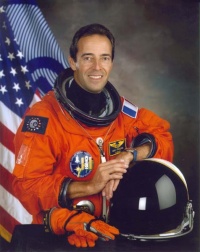Jean-Francois Clervoy
From The Space Library
 Jean-Francois Clervoy | |
| Birth Name | Jean-Francois Clervoy |
|---|---|
| Birth Date | Nov 19 1958 |
| Occupation | Astronaut, European Space Agency |
Contents |
[edit] Personal Data
Born November 19, 1958, in Longeville-les-Metz France. He therefore considers himself as Lorrain Mosellan, but also as Toulousain by adoption. Married to the former Laurence Boulanger. They have two children. Their parents, Jean (French Air Force, Ret.) and Mireille Clervoy, and Robert and Huliette Boulanger, reside near Paris, France. Jean-Francois enjoys racquet sports, skill games, canyoning, skiing, and flying activities such as boomerang, frisbee, kites.
[edit] Education
Received his baccalaureat from College Militaire de Saint Cyr l' Ecole in 1976; passed Math. Sup. and Math. Spe. M' at Prytanee Militaire, La Fleche in 1978. Graduated from Ecole Polytechnique, Paris, in 1981; graduated from Ecole Nationale Superieure de l' Aeronautique et de l' Espace, Toulouse, in 1983; graduated as a Flight Test Engineer from Ecole du Personnel Navigant d' Essais et de Reception, Istres, in 1987.
[edit] Experience
Clervoy was seconded from the Delegation Generale pour L' Armement (DGA) to CNES (French Space Agency) when he was selected in the second group of French astronauts in 1985 and started an intensive Russian language training. Clervoy holds military and civilian parachuting licenses, military and civilian scuba-diving licenses, and private pilot license.
[edit] Spaceflight Experience
NASA/ESA EXPERIENCE: From 1987 until 1992 he directed the Parabolic Flight Programme at the Flight Test Centre, Bretigny-sur-Orge and provided technical support to the European Manned Space Programmes within the ESA Hermes crew office. From 1983 to 1987, Clervoy was also a lecturer in signal processing and general mechanics at the Ecole Nationale Superieure de l' Aeronautique et de l' Espace, Toulouse. Jean-Francois holds a commission as Ingenieur en Chef de l' Armement in the DGA. In 1991, he trained in Star City, Moscow, on the Soyuz and Mir systems. In 1992, he joined the astronaut corps of the European Space Agency (ESA) at the European Astronaut Centre (EAC) in Cologne. Clervoy was detached to the NASA Johnson Space Center/Houston in August 1992 to gain Space Shuttle mission specialist qualifications. In between his space flights, Clervoy was assigned as flight software verification lead in the Shuttle Avionics Integration Laboratory (SAIL) and as robotics display design lead for Shuttle and Station. After his third space flight, he provided collateral duties in the NASA-JSC Astronaut Office on "International Space Station display integration lead" within the Space Station Operations Branch. He flew twice aboard Space Shuttle Atlantis and once aboard Discovery for a total of 675 hours in space. Clervoy is a member of ESA's European Astronaut Corps, whose homebase is the European Astronaut Centre (EAC) located in Cologne, Germany. He is currently seconded to the ATV (Automated Transfer Vehicle) ESA project as Senior Advisor Astronaut in Les Mureaux (France). SPACE FLIGHT EXPERIENCE: STS-66 Atlantis (November 3-14, 1994), the Atmospheric Laboratory for Applications and Science-3 (ATLAS-3) mission was part of an ongoing program to determine the Earth's energy balance and atmospheric change over an eleven-year solar cycle. Clervoy used the robotic arm to deploy the CRISTA-SPAS atmospheric research satellite 20 hours after lift-off. The mission was accomplished in 175 Earth orbits, traveling 4.5 million miles in 262 hours and 34 minutes. STS-84 Atlantis (May 15-24, 1997), was NASA's sixth Shuttle mission to rendezvous and dock with the Russian Space Station Mir. As the Payload Commander, Clervoy's primary tasks were the coordination of the execution of more than 20 experiments, the operation of the docking system and the double module SPACEHAB, and the transfer of 4 tons of equipment between Atlantis and Mir. He was also trained as a contingency spacewalker on this mission. STS-84 was accomplished in 144 Earth orbits, traveling 3.6 million miles in.221 hours and 20 minutes. STS-103 Discovery (December 19-27, 1999), was an 8-day mission during which the crew successfully installed new instruments and upgraded systems on the Hubble Space Telescope (HST). Clervoy was the flight engineer for ascent, entry and rendezvous. He used the robot arm to capture and deploy the telescope, and to maneuver the suited astronauts during 3 eight hour long spacewalks required to repair and upgrade the telescope. The STS-103 mission was accomplished in 120 Earth orbits, traveling 3.2 million miles in 191 hours and 11 minutes. On his third space mission from April 3 to June 16, 2000, Kaleri participated as Mir-28 flight engineer. During the experiments "Plasma Crystal-2" the crew managed to get consistent organized spatial structures for the first time in weightlessness. Mir-28 was the last Mir mission. Kaleri logged 5 EVA hours in one spacewalk. The mission duration was 73 days. On his fourth spaceflight on ISS Expedition 8 from October 18, 2003 to April 30, 2004, Kaleri served as Flight Engineer aboard the International Space Station. Mission duration was 195 days and included one EVA of 3 hours and 56 minute duration.
[edit] Organizations
Member, Association of Space Explorers. Distinguished member of the French Aeronautics and Astronautics Association.
[edit] Special Honours
Three NASA Space Flight Medals. Two NASA Exceptional Service Medals. Officier de l' Ordre National de la Legion d' Honneur, Chevalier de l' Ordre National du Merite. Komarov and Koroliev Awards from the Federation Aeronautique Internationale.
[edit] Other Information
Mar-11
